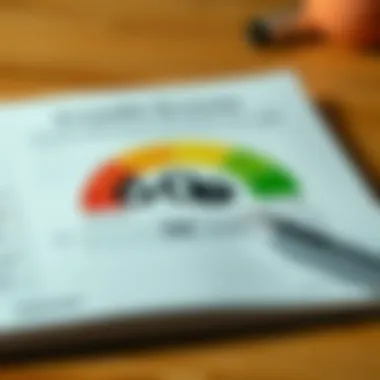Understanding a 660 Credit Score: Implications and Insights


Intro
Navigating the maze of financial health often leads you to one pivotal aspect: your credit score. A point of great interest is a score that stands at 660. is it a feather in your cap, or should you be worried? This particular score finds itself nestled within a gray area, often viewed as less-than-stellar yet not outright disastrous. It beckons a deeper exploration into what it means for your financial dealings.
Crafting a solid understanding of a 660 credit score requires us to sift through its various implications — both good and bad. What contributes to this number? How does it impact your ability to secure loans or even rent an apartment? As we uncover the layers of this subject, you'll gain insights that not only highlight the significance of your credit score but also arm you with practical strategies to enhance it.
So, let’s peel back the layers and get down to brass tacks.
Foreword to Credit Scores
Credit scores have become a vital part of modern financial life, shaping the way lenders, landlords, and even employers perceive an individual’s financial reliability. In essence, a credit score serves as a numerical representation of a person’s creditworthiness, influencing everything from loan approvals to rental applications and interest rates. This article zeroes in on a credit score of 660, providing both a foundational understanding of credit scores and the specific implications this rating carries.
Definition of Credit Score
A credit score typically ranges from 300 to 850 and is calculated based on an individual’s credit history. The score reflects the likelihood of a borrower defaulting on a loan. The higher the score, the more likely a person is to be seen as a reliable borrower. Various financial agencies, such as FICO and VantageScore, use different algorithms to determine this score, factoring in how timely the person pays bills, the amount of debt they carry, and the length of their credit history. A credit score of 660 situates itself right in the "fair" category of the credit score scale.
Importance of Credit Scores in Financial Decisions
Credit scores influence a myriad of financial decisions that individuals face. Here are some critical reasons why understanding credit scores is essential:
- Loan Approvals: Higher scores make it easier to secure loans with favorable terms. A score of 660 can still allow for certain approvals but may come with steeper interest expenses.
- Rental Applications: Landlords often check credit scores as a way to screen tenants. A 660 score might not raise too many red flags, yet it isn’t a golden ticket.
- Insurance Rates: Some insurance companies utilize credit scores to help determine premiums. Individuals with a score around 660 may not get the best rates.
- Employment Opportunities: Certain employers check credit scores as part of the hiring process, depending on the role.
Considering these points, it becomes evident that credit scores play a central role in numerous financial contexts. Not only are they crucial in acquiring loans and renting homes, but they also impact the overarching quality of life. Understanding the details and implications of a score like 660 is key for anyone wanting to navigate these waters successfully.
Breaking Down the Credit Score Scale
Understanding the credit score scale is crucial for anyone looking to navigate the financial landscape effectively. This section delves into why comprehending the category a score falls into can shape financial decisions profoundly. A credit score isn't just a number; it’s a key to opportunities. Knowing where a score of 660 stands allows individuals to assess their credit health and make informed choices that can either open doors or close them.
Categories of Credit Scores
Credit scores typically range from 300 to 850, with several established categories breaking down this overall spectrum. Here’s a quick look:
- Poor (300-579): A score in this range indicates serious credit issues. Lenders often consider individuals with poor scores high-risk borrowers; thus, they may either deny credit applications or offer loans at higher interest rates due to perceived risks.
- Fair (580-669): A score between 580 and 669 is considered fair. This category often includes those who may have some missed payments or other credit missteps. While credit may still be available, expect less favorable terms.
- Good (670-739): Falling into the good range means a more stable credit history. Here, borrowers generally enjoy decent rates and approvals on most loans.
- Very Good (740-799): Individuals in this category are seen as reliable borrowers. They usually receive the best interest rates and favorable credit offers.
- Excellent (800-850): This is where one’s credit shines the brightest. Those with excellent scores have demonstrated responsible credit behavior across the board and are often granted the most competitive financial products.
Understanding these categories matters because it gives a clearer sense of where you stand. For someone with a score of 660, it’s helpful to grasp that they fall into the fair category. Recognizing the implications of this positioning on future financial transactions can empower individuals to take steps toward improving their scores.
Understanding Where Falls in the Spectrum
A credit score of 660 can feel like standing on the edge of a cliff. It presents both challenges and opportunities. This score, landing at the awesome yet mild boundary between fair and good, can lead to various outcomes depending on the financial institution and their criteria. While it’s certainly not the best possible score, it’s also not the worst.
From a lender's perspective, a 660 score suggests caution. Banks and credit unions may offer loans, but often with higher interest rates than what borrowers with better scores receive. For instance, someone applying for a mortgage might find themselves in a position where a lender approves their application but at a steeper percentage, impacting their long-term financial planning.
On the flip side, this score should motivate individuals to focus on restoring their financial image. A 660 score signals that all is not lost; it’s a clarion call to address any lingering issues like late payments or high credit utilization. Borrowers in this range can refurbish their credit profile with careful strategies, inching their way toward the coveted good category.
Is a Credit Score of Good or Bad?
Understanding whether a credit score of 660 is good or bad is crucial for anyone concerned about their financial standing. This score sits in a noteworthy position on the credit score scale, often serving as a tipping point between "fair" and "good." For many individuals, a credit score can be the difference between having access to favorable loans or facing unnecessary hurdles during significant financial transactions.
A score of 660 doesn’t exactly roll out the red carpet but it certainly isn't an outright denial either. Many lenders might deem this score as a signal to proceed with caution. It indicates that the individual does have some credit history, but there may be blemishes or irregularities that give pause for concern. Hence, knowing the implications tied to this score can provide invaluable insights for better financial decisions.
Analysis of a Credit Score
A credit score of 660 is often categorized as fair, indicating that the individual has reached a moderate level of creditworthiness. Banks and lenders glance at this score and might interpret it as "less than ideal," resulting in higher interest rates or more stringent loan terms. However, it also reflects potential and room for improvement.
When diving into the specifics, it's clear that a 660 credit score doesn’t mean all doors are closed. It's a sign that while the user might have had some slip-ups in the past, there’s still an opportunity to grow and enhance one’s credit situation. Regular, on-time payments, responsible credit management, and being aware of one’s credit utilization can help shift this score into a more favorable range.
- Factors to Consider:
- A score near 660 may indicate a mixed payment history.
- Frequent inquiries for new credit can also lower the score.
- Credit utilization above 30% can be a red flag for lenders.
Comparative Perspective: vs. Other Credit Scores
When you put 660 against other credit scores, it becomes apparent that this score stands somewhere in the middle. To provide context, let’s break down the credit score scale:


- 300 - 579: Poor
- 580 - 669: Fair
- 670 - 739: Good
- 740 - 799: Very Good
- 800 - 850: Excellent
With a score of 660, one is just above “poor” but still not up to par with “good.” Lenders might compare a 660 score to scores like 700 or 720, where borrowers would typically enjoy better terms.
A score of 700 is often seen as the threshold for unlocking more favorable lending opportunities, making the path smoother for the borrower.
Overall, while a 660 credit score offers some accessibility to credit products, it highlights the importance of taking proactive steps for improvement. Understanding where you stand in relation to other scores can frame your financial strategies and future plans.
Factors Influencing Credit Score
Credit scores are not just numbers; they tell a story about an individual's financial behavior. There are various elements that determine these scores, and understanding them is vital for anyone aiming to improve their financial standing. For a score like 660, recognizing the influences behind it can lead to meaningful changes in credit management. This section will pinpoint the key factors that shape credit scores and their significance in enhancing overall financial health.
Payment History
One of the most influential factors in determining a credit score is payment history. It represents the track record of whether a person pays their bills on time. Late payments can severely impact a score, often for years. Here's the kicker: even just one missed payment can drop a score significantly. According to various studies, consistently making payments on time can account for nearly 35% of a credit score. That's a hefty chunk!
Benefits of Maintaining a Strong Payment History:
- Improved Credit Chances: Lenders favor individuals with solid payment records.
- Better Interest Rates: Timely payments can lead to lower rates when applying for loans.
Astronomers can talk about the vastness of the universe, but here on Earth, a strong payment history can be your shining star.
Credit Utilization Ratio
Next on the list is the credit utilization ratio, which illustrates how much of your available credit you are using. It’s calculated by dividing total credit card balances by total credit limits. Keeping this ratio under 30% is often recommended. If you have a credit limit of $10,000 but carry a balance of $3,000, your ratio is 30%.
Why It Matters:
- Indicates Financial Responsibility: A lower ratio shows that you're not overly reliant on credit and can manage your spending.
- Score Impact: This ratio contributes about 30% to a credit score and can cause fluctuations in scoring.
Imagine juggling balls in the air: the more balance you have, the better you appear. This principle applies to your credit as well.
Length of Credit History
Length of credit history looks at how long your accounts have been active. This may also include how long it’s been since accounts were opened, the age of your oldest account, and the average age of all accounts. The longer your history, the better for your score, as it indicates stability and reliability.
Key Considerations:
- New Accounts vs. Old Accounts: Opening new lines of credit artificially lowers your average account age, which could negatively affect your score.
- Maintaining Old Accounts: Even if you don’t use older accounts frequently, keeping them open can positively impact the length of your credit history.
In the realm of credit, time really is money, and a longer history tells lenders a more comprehensive story about your financial behavior.
Types of Credit Accounts
The variety of credit accounts you hold can influence your credit score as well. Accounts can include credit cards, mortgages, car loans, and student loans. Each type represents a different area of your financial responsibility and management. Lenders like to see that you can handle various types of credit, as this demonstrates your ability to manage multiple financial obligations.
Benefits of a Diverse Portfolio:
- Broader Credit Profile: It can enhance your desirability as a borrower by indicating versatility.
- Risk Mitigation: A mix of accounts can reduce the impact of unforeseen financial troubles.
Consider this like a orchestra: each instrument contributes to a richer sound, much like each type of credit contributes to your overall score.
Recent Credit Inquiries
Recent credit inquiries come into play when you apply for new credit. Every time a lender checks your credit, it counts as a hard inquiry. Too many inquiries in a short time can signal to lenders that you might be in financial distress, impacting your score negatively.
How to Manage Inquiries:
- Limit Applications: Apply for new credit sparingly to avoid multiple hard inquiries.
- Soft Inquiries Count Differently: Checking your own credit does not count as a hard inquiry and doesn't harm your score.
Inquiries should be like a drop of ink in water; they spread out but can become overwhelming if too many are present.
In summary, the various factors influencing a credit score include payment history, credit utilization ratio, length of credit history, types of credit accounts, and recent credit inquiries. Each element plays a pivotal role in shaping how lenders perceive your financial responsibility.


Understanding these factors can guide you towards making informed decisions to ultimately improve your credit health. As such, being mindful of these aspects is not just helpful; it’s essential for anyone with a score of 660 looking to elevate their financial future.
Impact of a Credit Score on Financial Opportunities
A credit score of 660 often sits in the middle ground between acceptable and mediocre, and understanding its influences on financial opportunities is crucial. This score can affect a variety of aspects of one's life, from securing loans to obtaining insurance, thus impacting one's overall financial wellness. The importance of acknowledging how a 660 credit score plays into these opportunities cannot be overstated. It sheds light on the greater mechanics of creditworthiness and illuminates paths to improve financial stability.
Loan Eligibility and Interest Rates
When it comes to loans, a 660 credit score can be a bit of a double-edged sword. Lenders may view this score as somewhat risky, leaving an individual in a grey area where they might still secure loans but with less favorable terms. Here’s what to keep in mind:
- Loan Types: While personal loans and credit cards may still be accessible, mortgage lenders might be stricter with their requirements, leading to potential denials based on risk assessments.
- Interest Rates: A credit score of 660 can lead to higher interest rates. This could mean paying significantly more over the life of a loan. For instance, a five-year car loan could cost a person hundreds more than it would at a higher score.
- Down Payments: Borrowers with scores below 700 might be asked to provide larger down payments, adding to the initial financial burden.
In summary, while a 660 score doesn’t automatically shut doors, it certainly doesn’t guarantee smooth sailing. Those looking to borrow might face higher costs and stricter terms, which can complicate financial plans.
Effects on Rental Applications
For individuals searching for rental properties, a credit score of 660 can present challenges. Many landlords and property management companies perform credit checks as part of their tenant screening process. Here’s how a 660 score stacks up:
- Approval Chances: While your score is above the threshold for many mainstream landlords, it may still trigger a thorough evaluation.
- Security Deposits: In some cases, landlords may request larger security deposits as a way to mitigate their perceived risk, further straining financial resources.
- Lease Terms: Those with a score around 660 could find themselves with less favorable lease terms or stricter house rules, as landlords tend to seek tenants with higher scores.
Navigating the rental landscape with a 660 score can be challenging, and it's paramount to prepare for the possibility of facing tighter scrutiny than others might.
Insurance Premiums
Interestingly, your credit score can also come into play when it comes to purchasing insurance. A score of 660 can lead insurers to consider you a higher risk, which ultimately translates to increased costs. Here’s how it impacts the insurance side:
- Higher Premiums: Many insurance providers compute rates based on credit scores, meaning that lower scores can lead to higher premiums, whether for auto insurance, homeowners insurance, or health coverage.
- Limited Options: Insurers might also limit your options, as some companies prefer to serve clients with scores in better standing, leaving those with a 660 score to settle for less.
- Bonding and Coverage Issues: Some potential employers in certain fields might even check credit when assessing applicants. This could impact job opportunities as well, especially in finance-related positions.
Having a 660 score can be troublesome when dealing with insurance, making it critical to seek quotes from multiple insurance providers to find the best match.
All things considered, a credit score of 660 signifies the importance of careful financial management strategies. Understanding its effects on loans, rentals, and insurance can pave the path for more informed decisions in managing one’s credit health.
Improving a Credit Score of
Improving a credit score of 660 is not just a matter of personal finance; it’s a crucial step toward achieving long-term financial goals. A score of 660 is often seen as a tipping point where individuals may face limitations in terms of loans, interest rates, or even housing options. By focusing on enhancing this score, individuals can unlock doors to better financial opportunities, ensuring they’re not left in the dust when they seek loans or credit. The journey to improvement is multifaceted, and understanding the key elements involved is essential.
Establishing a Timely Payment Record
One of the most important aspects of maintaining and improving a credit score is establishing a timely payment record. Paying off bills on time shows creditors that you are responsible and trustworthy. This is especially crucial for a credit score of 660, as even a small dip can have a significant negative effect.
- Set reminders: Utilize technology to your advantage. Set up alerts on your phone or calendar to remind you of upcoming due dates for all bills—credit cards, utilities, and any loans.
- Consider Auto-Pay: Enroll in auto-payment for bills you cannot miss, ensuring they’re paid on time. Just remember to keep an eye on your account balance to avoid overdrafts.
- Partial Payments: If full payment is not feasible, paying at least a portion can demonstrate good faith.
A simple missed payment can hang over your credit report like a dark cloud for years, so consistency is crucial to turn that 660 into something far more favorable.
Strategic Credit Utilization
Another key factor that plays a significant role in boosting a credit score is the management of credit utilization. This ratio directly reflects how much of your available credit you are using. It’s typically recommended to keep this ratio below 30%.
- Calculate Your Ratio: First off, add up all your credit card limits. Then, see how much credit you're actually using. For instance, if your limit is $10,000 and you're using $2,500, your utilization rate is 25%. That's in a good zone.
- Pay Down Balances: If you're hovering too close to the limit, focus on paying down those cards. If possible, try to make payments more than once a month if you can manage the cash flow.
- Increase Your Limits: If you’ve been a reliable borrower, ask for an increase in your credit limit. This will decrease your utilization rate, as long as you keep your spending in check.
By strategically managing how much of their available credit they use, individuals can positively impact their score and project financial prudence.
Limiting Credit Applications
When looking to improve a 660 credit score, people often overlook the impact of credit inquiries. Each time you apply for new credit, it can trigger a hard inquiry on your report, which can slightly reduce your score temporarily.
- Think Twice Before Applying: Only apply for credit when absolutely necessary. Every application might feel like a need, but it's essential to consider the bigger picture.
- Research Options Before Applying: With countless credit options available, do thorough research. You can often prequalify without impacting your score. This gives you a sense of whether you'd be approved by a lender without triggering an inquiry.
- Space Out Applications: If you must apply for credit, try to space them out over time. This way, the effects of inquiries will diminish, and your credit score can recover.
By exercising restraint and being strategic about credit applications, the chances of seeing that 660 improve grow significantly. Each of these approaches—timely payments, strategic credit utilization, and judicious credit applications—forms a solid foundation for credit score advancement and better financial health.
Building and maintaining your credit score is like tending a garden; it requires regular care, attention, and a little bit of patience.
Long-Term Strategies for Credit Health


When diving into the world of credit scores, particularly a score like 660, it’s vital to not just look at the immediate numbers but to focus on long-term strategies that can ensure credit health. A credit score isn’t stagnant; it evolves based on your financial behavior over time. Developing a long-term approach to managing your credit can profoundly influence your financial opportunities.
Monitoring Credit Reports
Staying on top of your credit reports is a fundamental practice. Monitoring your credit reports enables you to catch errors that might plummet your score below its potential. You are entitled to a free credit report from each of the major credit bureaus annually. Combing through these documents can reveal inaccuracies, late payments that aren’t really late, or even accounts that you don’t recognize.
- Check for Errors: Look for discrepancies in your personal information, payment histories, and any sudden accounts.
- Regular Updates: Since your credit report updates every month, check regularly to ensure everything’s accurate. Detecting issues early can help you tackle them before they escalate.
- Score Tracking: Many services now offer free score tracking. While the exact score may not always align with what a lender sees, tracking trends can help you understand your credit dynamics.
"An ounce of prevention is worth a pound of cure," especially when it comes to managing your credit.
Diversifying Credit Types
Credit scoring models often favor diverse credit types. This means exploring various forms of credit can have a positive impact on your score. It’s not just about having credit; it’s about how well you manage different types. Here’s how to diversify effectively:
- Mix of Credit Accounts: Aim for a balance that includes credit cards, installment loans, and perhaps a mortgage. Lenders appreciate when applicants have managed various kinds of debt responsibly.
- Avoid Opening Too Many Accounts at Once: While it may be tempting to open multiple accounts for diversity, doing so can hurt your score in the short run due to multiple inquiries.
- Use What You Have Wisely: If you already have different types of credit, make sure you handle each responsibly. Late payments on even one account can impact your overall standing.
Seeking Professional Guidance
When in doubt, seeking help from professionals can be a game changer. Financial advisors or credit counselors provide insights based on your specific situation and help tailor strategies to your needs. Consider the following:
- Credential Verification: Always verify that the counseling agency or advisor is reputable. Check for any accreditations and look for reviews or testimonials.
- Personalized Advice: A good advisor will analyze your financial habits and offer a roadmap that aligns with your long-term goals.
- Avoiding Scams: The world of credit improvement is ripe with scams. Seeking professional guidance can protect you from misinformation and predatory practices.
Establishing a long-term plan centered on these strategies can enhance your financial well-being. The objective is to not just nurse a 660 credit score but to nurture a robust credit profile that serves you well over time.
Common Myths About Credit Scores
Credit scores serve as a pivotal component in the realm of personal finance. As individuals navigate loans, rental agreements, and various other financial decisions, understanding the nuances of credit scores becomes essential.However, several myths and misconceptions cloud the waters. It’s crucial to demystify these inaccuracies since they can lead to poor financial choices.
Misconceptions Regarding Credit Score Ranges
One of the most common misconceptions lies in the belief that a good credit score is a fixed number. Many people are under the impression that anything above 700 is automatic gold, leaving scores around 660 in the shadows of bad credit. This is an oversimplified view that can mislead individuals into thinking they are stuck if their score is on the lower end of the 'fair' category.
In reality, the range of credit scores varies by scoring model. For instance, FICO scores usually range between 300 and 850. What one needs to understand is that a score of 660, though not ideal, doesn’t mark the end of the line. It suggests that while there are challenges, there’s still room for improvement. To accurately assess their position, consumers should familiarize themselves with their specific scoring model.
- Credit score categories: 300-579 (Poor), 580-669 (Fair), 670-739 (Good), 740-799 (Very Good), and 800-850 (Excellent).
- Context matters: A 660 might be considered fair in some regions or for certain lenders, while others may see it as a roadblock.
Understanding these ranges helps individuals set realistic goals for improvement.
False Beliefs About Credit Inquiries
Another myth that often circulates among those seeking to clean up their credit is the incorrect belief that any credit inquiry will harshly impact their score. There are two types of credit inquiries: hard and soft inquiries. Many folks confuse the two, beggining the worry of every little application they make because they think it's going to send their credit score plummeting.
- Hard inquiries occur when you apply for credit, such as loans or credit cards. These can drop a score by a few points, but the impact is not permanent. In fact, it typically fades within a few months.
- Soft inquiries happen when you check your own credit score or when a lender checks it for preapproval.
Understanding this distinction is vital, as it allows individuals to make informed decisions about when to apply for new credit. Knowing that two or three inquiries within a short period won’t devastate your score is a relief, yet consistently applying for multiple accounts can be detrimental. Informative resources about this topic are available at sites like experian.com and nerdwallet.com.
"Your credit score is a living thing. Like a garden, it grows with care and attention."
In summary, shedding light on these common myths empowers individuals to take charge of their credit health intelligently. If we can recognize that a score isn't a rigid label but a reflection of financial habits, it opens the door to better credit management practices.
The End
A thorough grasp of a credit score of 660 is crucial for anyone navigating the complex world of personal finance. A score in this range can be the difference between gaining favorable loan terms or grappling with higher interest rates. It highlights not just one's borrowing reliability but also reflects broader financial health. By understanding the implications of this score, individuals can make more informed decisions regarding their finances, from applying for loans to managing credit wisely.
Summary of Key Insights
This article has explored several pivotal points regarding a credit score of 660:
- Position in the Credit Score Range: This score is often perceived as average, but it plays a significant role in accessing financial opportunities. It sits snugly between being an acceptable score and one that might raise eyebrows with lenders.
- Factors Influencing Credit Score: A myriad of elements affects this score, from timely payments to credit utilization. Recognizing these factors empowers individuals to take control of their financial narratives.
- Long-Term Implications: Maintaining a score of 660 impacts loan eligibility, interest rates, and even rental applications. Understanding these implications helps in forming effective strategies for better financial health.
- Strategic Improvements: Practical steps, including timely payments and prudent credit usage, can help elevate scores over time.
Recognizing the intricacies of credit scores is essential in today’s financial landscape. A score of 660, while not ideal, is manageable and can be improved with diligent efforts and informed decision-making.
Final Thoughts on Credit Scores
In the end, credit scores are more than mere numbers; they are windows into one's financial behavior and management. Everything from the type of lifestyle choices one makes to the responsibility demonstrated in credit management influences these scores.
For individuals with a 660 credit score, the key takeaway is that improvement is achievable. It might require some discipline and strategy, but transforming a mediocre score into a robust one is certainly within reach. Often, small changes can yield significant benefits. As one works on improving this score, it's worth remembering that financial literacy is a journey, not a destination. Staying informed and proactive can pave the path toward better credit health.
“Financial stability is not about just earning money; it’s about managing credit, spending wisely, and planning ahead.”















